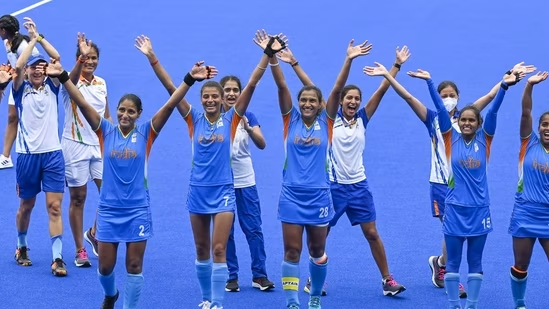Tokyo 2020: Indian women's hockey team books date with history
Unshakeable self-belief dissipated the air of disbelief at the Oi Hockey stadium in Tokyo on Monday. When the final hooter sounded,the Indian women’s hockey team were through to their first Olympics semi-final, beating three-time champions Australia, a team they had beaten just once in seven previous encounters in the last five years.  PREMIUM
PREMIUM
Every player in blue ran wildly across the turf; they hugged and they collapsed on the turf. They screamed in joy at the sky. Their coach cried.
This was a team that lost all its matches in Rio 2016, including a 6-1 drubbing at the hands of Australia. A team that qualified for the Olympics only once before Rio and now Tokyo — in 1980, when women’s hockey was first introduced. A team that started their Tokyo campaign with three losses, before mounting gritty comeback wins in the next two matches to make the quarterfinals. A team that was supposed to be brushed aside by the mighty Aussies.
What made the victory sweeter was that it captured the story of Indian hockey’s dramatic turnaround. Less than 24 hours earlier, the men’s hockey team made it to their first semi-final in 49 years. They play world champions Belgium on Tuesday morning. The heroics from the women’s team may be just the boost they needed.
“For Indian hockey, this is a proud moment. Both men and women’s teams are in the semi-final,” women’s team captain Rani Rampal said. “I believe when team sports do well it brings the country together.”
Monday’s result shattered statistics, and a reputation.
The Indian team played with calm, even when they were under siege from the Aussies, who had nine penalty corners in the match. Each of those was saved.
Australia also had a shot, through Ambrosia Malone, that hit the post in the second minute of the match, but that was as close as they would get. India too hit the frame, four minutes later, when Vandana Katariya — who scored a hat-trick against South Africa in India’s previous encounter — hoicked a pass across the face of goal that Rampal tried to tap in at the far post.
India got just one penalty corner, and Gurjit Kaur shrugged off her indifferent form to score perhaps the most important goal in Indian women’s hockey thus far, with a drag-flick in the 22nd minute. It was the breakthrough they needed, and India held on to the lead like their lives depended on it.
Australia repeatedly made circle penetrations — 17 through the match, compared to India’s nine — but found the path to the goal crowded by Indian players, who ran untiringly up and down the pitch. Deep Grace Ekka was rock solid, holding the defence together and making critical interceptions, stopping shots and winning one-on-one duels. Goalkeeper Savita Punia was always at the right place at the right time, making a number of superb saves.
That the Indian team was unfazed by the attack showed in the poised way in which they made counter-attacks, passing their way out of their danger area with poise and confidence and sprinting up in attack.
Australia, their every attack thwarted, grew more and more frustrated.
ALSO READ | TOKYO OLYMPICS 2020 FULL COVERAGE
There were nervous moments towards the end, but still no panic when Australia got a penalty corner via referral with six minutes left.
“We were talking in the dugout that they will not get the PC, just stay calm and we were saying that we are almost there, just five more minutes, (we need) to keep the ball upfront,” Rampal said.
That penalty corner saved, Australia immediately got another one. This one resulted in a goalmouth scramble that must have been hair-raising for the Indian coaching staff. As the clock ticked down the final 10 seconds, you could already hear the shrieks of joy from the dugout. The Australian women covered their faces and dropped to the turf. The Indians raced across it, hugged each other, and celebrated with abandon.
“I told the girls that the most important thing is to stay in the moment,” said coach Sjoerd Marijne. “They were very good in defence and won those crucial one-on-one tackles that gave us a lot of confidence.”
India will play Argentina in the semi-final, a team they know well, having toured the country earlier this year. They played three matches against the senior Argentina team there, losing two and drawing one.
The start to the Indian campaign in Tokyo could not have been worse. Three straight losses meant they had to win their final two group stage matches to have a chance of progressing to the quarters. This is when the turnaround started. Victories against Ireland and South Africa kept them afloat. Then they earned a bit of luck when England beat Ireland, allowing for India to finish fourth in the group and qualify for the knockouts.
“We never lost belief in ourselves. Rio gave us very unhappy memories and we had put in so much work in the last five years, that we believed we could bounce back,” said Rampal. “We wanted to go out there and give it our all.”
In contrast, Australia had enjoyed an irrepressible run to the quarterfinals by topping their Group, winning all five matches, scoring 13 goals and conceding just one. India, in contrast, had conceded 14 and scored seven before the quarterfinal.
None of that mattered.
Experience unrestricted digital access with HT Premium
Explore amazing offers on HT + Economist Start 14 Days Free Trial Already Subscribed? Sign In
Disclaimer: The copyright of this article belongs to the original author. Reposting this article is solely for the purpose of information dissemination and does not constitute any investment advice. If there is any infringement, please contact us immediately. We will make corrections or deletions as necessary. Thank you.







